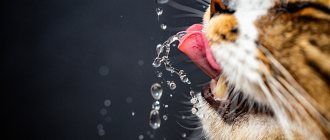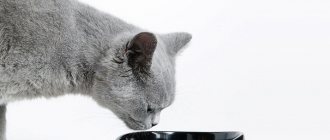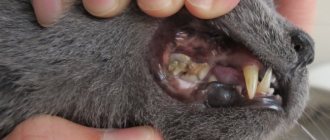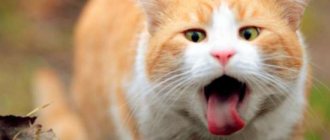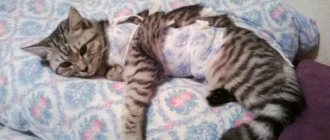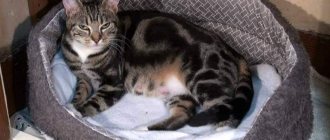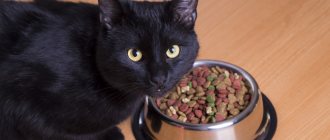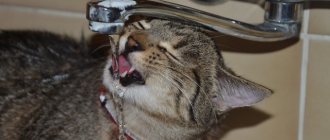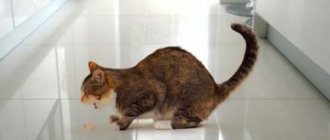Responsible owners always monitor the living conditions of their pets, so any oddities in behavior do not go unnoticed. It is very important to maintain a constant amount of food, water and vitamins. This is the only way the pet will remain healthy. That is why, when it is discovered that a cat drinks a lot of water, you need to quickly identify the cause and regulate the animal’s regime.
About the norm
Changing your pet's needs is not always a bad thing! Therefore, there is no need to panic if your cat drinks a lot of water. The reason may be completely harmless, and the consequences of changing the drinking regime will not affect the animal’s well-being at all. Felinologists do not have a definite figure for mandatory water consumption - this number depends on nutrition, climate, breed, age and many other factors.
Attention! Do not try to force water on a healthy cat! With rude actions you will not only not achieve the desired result, but will also frighten your pet. The animal, as a rule, knows very well how much water it needs!
Typically, veterinarians advise calculating the amount of required moisture so that there is 0.03 milliliters of liquid per gram of pet’s body weight. It doesn’t have to be just water; milk, canned food, and wet food will do.
It is very important to pay attention to your pet's diet. If a cat drinks a lot of water, the reasons may lie solely in a change in diet. Dry food tends to “pull” moisture from the animal’s body. Because of this, it is recommended to equalize the amount of water to the weight of food in a ratio of 1:3.
How much water should a cat drink per day?
Cats do not need a lot of liquid, but your pet's daily diet must include clean water. Broths and other liquid formulations cannot fully replace regular drinking water. The average daily water intake for a cat is 40-50 ml of liquid per 1 kg of weight.
If a cat eats wet food and eats other nutritious foods well, a certain portion of its daily fluid intake will enter its body. She gets the rest with drinking water. This is why the owner often thinks that the cat does not drink water at all or drinks very little.
Diseases
Diabetes mellitus in a pet is one of the diseases that causes constant thirst. The cat's pancreas stops producing the required amount of the hormone insulin, which leads to problems delivering glucose to the cells. The necessary substance does not reach the kidneys in sufficient quantities. An important organ cannot filter moisture properly, and the cat quickly loses water.
Chronic renal failure is a very common incurable disease in older animals. Cells in an important organ cease to function normally and retain the required amount of moisture.
If your cat drinks a lot of water, then it is likely that you are experiencing one of the symptoms of hepatitis. The disease is caused by inflammatory processes in the liver. With proper treatment, the problem can be quite easily dealt with.
Attention! Many viral diseases and inflammatory processes are accompanied by increased thirst. Try to provide your pet with enough water so that his body continues to fight the disease.
Insulinoma (that is, inflammation of the pet's pancreas) is also accompanied by the fact that the cat often drinks water. The reasons for increased thirst also lie in excess insulin production. It is extremely rare in cats.
The cat drinks a lot of water and loses weight
Thirst and weight loss are a formidable pathological symptom.
The combination of thirst and weight loss develops in the following situations:
- poor nutrition;
- pathologies of the urinary tract;
- poisoning leading to vomiting and diarrhea;
- hormonal disorders;
- diabetes.
If a cat feeds on table scraps, a lot of salt and spices enter the body. When feeding only meat or fish, an excess of proteins occurs. The body spends a lot of energy processing such food, and the absorption of nutrients remains low.
When protein overfeeding, uric acid or other uric salts are formed, which are poorly soluble in blood or urine. If it is not possible to remove toxins, self-poisoning develops. That's why the cat drinks all the time. The struggle for survival comes to the fore; there is no time to digest the consumed food. To stop the intake of toxins, you need to stop eating.
In case of urolithiasis or cystitis, the primary task is to prevent salt crystallization. To prevent oversaturation of solutions, they are diluted with drunk water.
Be sure to read:
Discharge from the eyes in cats: normal or pathological, causes, what to do, treatment and prevention
In renal failure, the kidneys are unable to filter certain substances, such as phosphates. In elevated concentrations the compounds are poisonous. They have to be diluted. For the same reason, thirst occurs in diabetes mellitus: you need to dilute the glucose.
Natural causes
Often, owners, asking the question “Why does the cat drink a lot of water?”, unnecessarily dramatize the situation. Don’t forget about the completely natural (and harmless!) reasons for your pet’s increased need for water:
- increased physical activity (long walks, hyperactivity, playfulness, training);
- increased room temperature, stuffiness, hot season;
- pregnancy or lactation period;
- age (kittens practically do not need additional moisture, and older animals drink a lot);
- dietary habits (dry food or salted foods).
Don't worry or worry too much. If there are no other alarming symptoms in your pet’s behavior, then you just need to give your pet a little more water than usual.
Attention! It is necessary that the water in the drinking bowl is always fresh (changed every day). Do not give your pet tap water or distilled water. It is recommended to leave the filtered or boiled liquid in a bowl in a visible place. The pet must have free access to it.
Why does the cat do this?
This behavior was inherited by cats from their ancestors. Even though a cat is a predator, it is not at the top of the food chain and is also at risk of being eaten. That's why she needs to be on alert everywhere and always. The threat can also lurk under water, so by lowering its paw, it is easier for the cat to check the surface and find out whether someone is hiding there or not.
Another reason is that the water may become stagnant or contaminated by the carcasses of dead animals, and a small sample of the water from the paw will let the cat know whether it is suitable for drinking or not.
Finally, older animals will often test the water with their paw due to poor eyesight. This is how they find out the depth and other parameters of the reservoir.
Other reasons
However, it also happens that none of the listed reasons are suitable. Then the owners do not understand why the cat drinks a lot of water, what it means and how to treat it. Among these reasons are:
- increased sweating;
- taking special medications (diuretics, corticosteroids, sometimes due to side effects of sedatives or painkillers);
- loose stools;
- discharge from the genitals;
- dropsy (a disease characterized by the accumulation of fluid in the cavities and tissues of the body);
- stress and mental disorders;
- brain pathologies.
If you notice that your pet is drinking much more water than usual, you should first conduct a home examination, and then (if there is no harmless explanation) contact your veterinarian!
The cat pees often: treatment
In this case, it is not necessary to treat the symptom itself, but to look for the original source of the problem and deal directly with its elimination.
What will help your pet get rid of frequent urination should be decided by your tandem with the treating veterinarian; without a doctor you will not make the correct diagnosis and will lose valuable time.
- If you contact a veterinarian with this problem, he may prescribe the following tests and examinations:
- Blood tests.
- Urine tests.
- Ultrasound.
- X-ray.
- For blood glucose levels.
- For the presence of acetone.
If a cat is diagnosed with cystitis, the doctor will prescribe a course of antibiotics, bladder lavage, antispasmodics, and a diuretic.
If a cat is diagnosed with urolithiasis, then it is necessary to ensure the free flow of urine, for which a catheter is inserted under general anesthesia. Surgery to remove bladder stones and intensive symptomatic treatment are often required. Under no circumstances should you try to treat this disease yourself, as only specialists will save your furry pet from death!
If your pet has diabetes, doctors will determine what type it is and prescribe appropriate treatment. You may need to inject your cat with insulin. If you have type 2 diabetes, which is insulin-independent, a special diet, weight loss for obesity, and medications to improve pancreatic function will help.
If the cat is simply marking its territory, then this condition does not require special treatment, since it is not pathological. You may choose to have the animal neutered, after which the behavior usually goes away.
If the cause of frequent urination is stress, try to eliminate its cause. However, to make sure that the animal is truly healthy, take it to the vet.
What does each discharge indicate when vomiting occurs?
Of course, an animal can vomit not only bile, but also other types of secretions. In order not to cause unnecessary panic, you need to understand the specific cause of this type of vomiting.
We suggest you familiarize yourself with: Shells of marine mollusks, how to remove a mollusk from the shell
Before the onset of this symptom, the pet will experience rapid breathing, and involuntary reflexes may appear, namely swallowing. There is also strong salivation.
Before the onset of vomiting, the pet notices rapid breathing
If spasms begin after eating, this may indicate that your pet has eaten too much grass or swallowed a large hairball. This caused irritation in the stomach.
For example, if a cat has vomited 1 or maximum 2 times and feels quite normal, then there is no particular reason to worry. You just need to monitor your pet’s condition for 24 hours, and if everything is fine, then you don’t have to see a doctor.
It is important to understand that inflammation of the uterus or intestines, as well as feline distemper, are also accompanied by such discharge. Therefore, if these symptoms are systematic, you should not postpone a visit to the doctor.
White foam is considered the safest; if an animal burps such a mass, then there is no need to worry too much. Of course, if this is a one-time spasm.
The most common cause of bile secretion is considered to be problems with the liver or kidneys.
If we are talking about bile or blood, then you should be especially careful. The most common cause of bile secretion is considered to be problems with the liver or kidneys. The same reason may be for green discharge. Moreover, in the latter case, in addition to liver disease, stomach problems cannot be ruled out.
When there is blood in the discharge, there may be other reasons. For example, scarlet blood indicates any damage to the pharynx or esophagus. The first thing you need to do is examine your pet's throat; most likely, wounds will be found there. Dark blood indicates damage to the stomach itself; here you cannot do without the help of a doctor.
If you are vomiting, you need to examine your pet's throat.
Pathology in adult and young cats
Cats of any age can suffer from increased thirst.
Symptoms in children and adults appear the same, but the causes of polydipsia differ:
- in kittens, pathology is more related to their physical activity;
the prerogative of sexually mature animals is a surge of hormones during the period of “sexual arousal”;- decrepit cats get sick a lot and eat little, so they suffer from dehydration more often than others.
Any suspicion of polydipsia, regardless of the pet’s age, requires urgent consultation with a specialist.
Diagnostics
One of the first diagnostic methods is to take a blood test, which determines the presence of inflammation, anemia and altered red blood cells. It is also necessary to take a biochemical analysis to determine liver enzymes (ALT, AST and alkaline phosphatase). The level of direct and total bilirubin is also assessed.
Normal indicators in cats: ALT – from 19 to 78 units/l, AST – from 9 to 30 units/l, Bilirubin – from 2 to 16 µmol/l
A urine test also evaluates the presence of bilirubin and urobilinogen.
Blood smears are performed to determine parasites, as well as serological tests for feline immunodeficiency viruses, leukemia and leptospirosis.
If effusion or ascites is present, fluid analysis is performed.
To examine the liver, ultrasound is used, as well as radiography - it determines the presence of fluid, enlargement of the liver or spleen, as well as metastases or tumors.
Sometimes it is necessary to perform a liver biopsy and bile collection for bacteriological and cytological analysis.
For prehepatic jaundice, a blood clotting test (prothrombin index), an immune-mediated hemolytic anemia test, and a water-salt test (to determine the agglutination (clumping) of red blood cells) are performed.
How to train a cat to drink from a bowl?
Let's look at some ways to teach your pet to drink from a bowl:
- It is necessary to place a container with water at a distance from the dishes with food. After all, due to its instincts, a cat may refuse water due to its close location to food.
- The animal may not like the fact that the water is warm, so it is necessary to change it to cooler water more often.
- You can try replacing the water container itself. So, instead of a plastic container, put glass, porcelain or metal dishes. If your pet regularly turns over a bowl of water, you can offer him a more stable dish with a rubber base. Even the most playful and curious cat will not be able to turn over such a water container.
- There are also automatic waterers or drinking fountains that provide constant circulation of water. Due to the fact that water constantly passes through purifying filters, it remains clean and enriched with oxygen. This design allows the cat to drink water not only from a bowl, but also from the tap.
- You can try offering your cat different types of water. Perhaps the animal will choose one of them.
We must not forget that the cat should always have access to water. When leaving for work for the whole day, you can open the water tap slightly so that the water from it does not flow, but drips. Then the animal will be able to drink, even if the water in the bowl does not suit it.
With a normal drinking regime in cats, the risk of urinary tract diseases, as well as other chronic diseases that worsen with age, is significantly reduced. When a cat drinks enough water, the likelihood of stone formation decreases as the urine becomes less concentrated. To reduce the risk of diseases of the pet’s genitourinary system, there are also many different foods that can be purchased at the Homeovet pet store. When contacting a veterinary clinic, you can receive recommendations on feeding and drinking regime for your pet. This is especially true for older cats, who may not drink enough water, which will lead to dehydration and contribute to constipation and kidney disease.
Causes of frequent urination and decreased urine volume
To determine why a cat often goes to the toilet in small, small amounts, it is necessary to study the main causes and symptoms of associated diseases.
How to give a cat deworming tablet and how often to give it
This pathology can occur at any age of the pet. At risk are neutered cats who do not receive a balanced diet. During urolithiasis, stones form in the body, which get stuck in the ureter and block the flow of urine. If the disease is not treated, the pet may die due to stagnation of urine.
Symptoms of the disease include frequent urge to go to the toilet, as well as urine with drops of blood. Kidney stones form over time because it all starts with sand.
Sand does not interfere with the flow of urine; at this stage it is very difficult to detect the disease. The sand gradually accumulates and forms stones, which begin to bother the animal.
Important! Treatment should begin while the fractions are small and easily excreted in the urine. Otherwise, there is a risk of death of the animal.
Urinary incontinence
When identifying the reasons why a cat began to pee a lot, it is necessary to pay attention to the disease - urinary incontinence. This disease does not cause discomfort in the cat, but it does not appear just like that. Often the pathology is caused by internal infections, injuries or stressful situations.
In this case, urine has a normal color, without impurities and a specific odor.
A comprehensive examination of the whole body is used as a diagnosis.
The cat pees little, but often in some cases due to the development of kidney failure. In this case, the kidneys perform poorly the function of processing and removing urine. Due to impaired fluid removal in the body, the functioning of other systems is disrupted.
Problems often develop in pets older than 8 years. Among the main symptoms are:
- frequent urination;
- decreased activity and lethargy of the cat;
- your pet often drools;
- the cat begins to lick frequently, especially the perineum;
- the cat suddenly begins to lose weight;
- the oral mucosa becomes pale;
- swelling appears.
Important! Kidney failure must be treated immediately. It should be remembered that only a veterinarian can prescribe the correct medications after an examination.
Sometimes the cause of frequent urination is psychological problems. In this case, pets may unintentionally pee in the wrong place.
The reason may be:
- moving to another place of residence;
- sudden change of litter tray;
- replacing the usual food with another;
- bad relationship with the owner;
- the appearance of other animals in the house;
- a tray that is not removed for a long time.
Psychological problems can result in serious stress for a cat. Therefore, owners should not ignore the poor condition of their pet. If your pet shows aggression, starts yelling and becomes anxious, you should take him for a consultation with a doctor to determine the reason for this behavior and frequent urination.
The main infections of the genitourinary system include cystitis. The disease causes inflammation of the bladder mucosa and occurs in both male and female cats.
Causes of cystitis:
- infectious lesions of the kidneys and urinary tract;
- metabolic disease;
- poor nutrition;
- long stay in the cold;
- sand and kidney stones.
Symptoms:
- frequent urination;
- the appearance of blood or pus in urine;
- the animal cannot calmly go to the toilet because it is in pain;
- pets begin to pee in other places, since they associate the tray with pain.
Cystitis requires urgent treatment, as it entails serious consequences
Diabetes
The main symptoms of this disease are frequent drinking and urination. Mostly adult cats are at risk, but kittens can also get sick. This disease is diagnosed only within the walls of the clinic, where tests and analyzes are carried out.
Important! Obese cats are most susceptible to diabetes.
Other symptoms of diabetes:
- the cat prefers to lie down and shows minimal activity;
- urine smells like acetone;
- weight drops sharply;
- vomiting is possible.
The sooner the owner contacts the veterinarian with the cat, the greater the chance of successful treatment. The visit should not be postponed, since in severe stages of the disease it is more difficult to help the cat, so the risk of death increases.
Is this always a pathology?
Some cats drink in small portions, quietly absorbing water. Others do not have time to add liquid to the bowl.
Excessive thirst is called polydipsia and belongs to the category of pathologies.
To understand how serious the problem is and whether it is worth sounding the alarm, several factors must be taken into account. But you should start, first of all, from the optimal amount of fluid that your pet needs.
How to determine the norm
There is no strict parameter regulating how much water a cat should drink. Everything is determined individually, taking into account the characteristics of the animal’s body.
Experts say that for every kilogram of weight, cats need to consume 20-40 ml of liquid daily. A pet weighing 5 kg should be given about 100-200 ml of water per day.
But even this norm can be called conditional, since the amount is total and includes not only pure water, but also that which is in food.
A cat may drink a little more than the norm if the food is salty or the weather is hot.
When a pet drinks 2 times more than the calculated result, this is already a reason to take the animal to the veterinarian for examination.
Signs of dehydration
Experiments with bowls do not always bring results immediately, and the cat continues to be mischievous. This behavior threatens dehydration and the acquisition of unpleasant diseases.
A small test can help identify dehydration in a cat. Pull back the skin on the cat's neck and watch it return to its original position. If this happens quickly, your pet is fine.
If the fold of skin is difficult to pull back, and then it slowly straightens, the cat is dehydrated. If there are other alarming symptoms, the animal must be immediately shown to a veterinarian.
